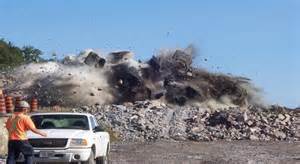
© gumtree.co.za
Fly-rock is material ejected from the blast sight by the force of the explosion. It has been known to travel as far as 1000 feet.
It is a severe hazard in surface mining operations due to the frequent dilemma of having to blast a section of rock within the close proximity of personnel and equipment. [7]
© banthequarry.org
When an explosion exerts a force on a segment of material, the material splits into smaller pieces, called fragments. These fragments are projectiles, because they are projected through the air by an impulse. Knowing how far they can travel can be an essential duty for the explosives engineer in setting up a safety perimeter.
Projectile motion calculations can be demonstrated through an application related to fly-rock.
Example:
An explosion shatters the ground into thousands of rock fragments, each weighing about 1.0 kg, and exerts on each of them a force of about 161 Newtons for a duration of 0.5 seconds. What is a safe distance to be at?
The momentum of each fragment must be calculated using Newton's second law in terms of momentum so that their velocities can be solved.
Newton's second Law for momentum: F = dp/dt Since initial momentum is zero, dp = pf - 0
Since P = mv ==> F = mv/dt
Plugging in our values,
161 N = (1.0 kg)v/0.5
==> 80.5 = (1.0)v
==> v = 80.5 m/s
After the impulse of the explosion, the fragments have velocities of 80.5 m/s.
Fragments are being sent in all directions, but the launch angle of 45° gives the longest horizontal distance that can possibly be traveled. Therefore, 45° will be used as the launch angle for the maximum distance calculations.
First, the duration of flight (T) must be found by calculating how long it will be in the air before gravity brings it back down.
using vf = vi + at and for vertical motion vyf = 0 and vyi = v(sin(45))
therefore, -v(sin(45) = at
-(80.5 m/s)(sin(45)) = (-9.81)t
t = 5.81 s
t = 5.81 seconds is the time duration it takes for the fragment to reach its peak height. For total time duration of the flight, this is multiplied by 2 since it takes the same amount of time to reach peak height as it does to come down,
T = 5.81(2) = 11.62 s
For HZ distance, Dx = vxt
vx = v(cos(45))
Dx = v(cos(45))t
Dx = (80.5)(cos(45))(11.62)
Dx = 661 meters
It is best to round up to 700 meters do to uncertainty.
Therefore, 700 meters is a safe distance to be from the blast. [6]
Home Page
Introduction
Powder Factor
ANFO
Force of an Explosion and Conservation of Momentum
Fly-rock
References
